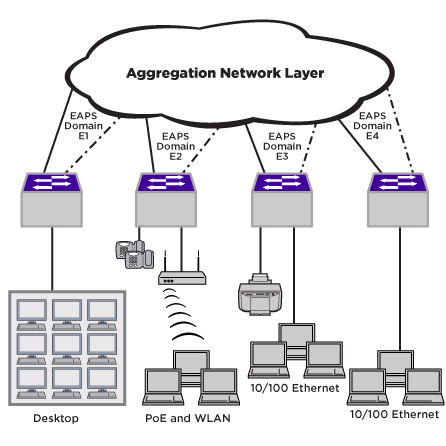The unified access network layer makes use of EAPS (Extreme Automatic Protection Switching) in a partial-meshed ring topology for maximum resiliency. The edge of the network is the first point of entry for client devices such as PCs, servers, VoIP phones, wireless devices, and printers.
Utilizing EAPS and redundant uplink ports on edge switches increases network resiliency and availability. Edge switches connect their primary and secondary uplink trunk ports to one or more switches in the aggregation network layer (as shown in Converged Network Edge (Unified Access Layer)). If the primary uplink port fails, traffic can use the alternate secondary uplink.

In this sample network, each edge switch is configured with a unique EAPS domain and control VLAN (Virtual LAN). Protected VLANs can overlap across multiple EAPS domains, or remain local to their own domain.
By putting each edge switch and VLAN into a separate EAPS domain, you gain resiliency and management benefits. First, any link or switch failures in one ring do not affect the other edge switches. Also, this type of modular design allows you to add edge switches easily without impacting other parts of the network. Troubleshooting becomes easier as the scope of failures can be quickly isolated to a specific EAPS ring or switch.
This section describes how to design the access edge network switches as EAPS transit nodes to provide Ethernet L2 connectivity services. In this example, upstream aggregation switches perform Layer 3 (L3) inter-VLAN routing functions. Although not discussed in the scope of this section, the edge switches could also be configured with additional routing, QoS (Quality of Service), WLAN (Wireless Local Area Network), or security features.

 Print
this page
Print
this page Email this topic
Email this topic Feedback
Feedback